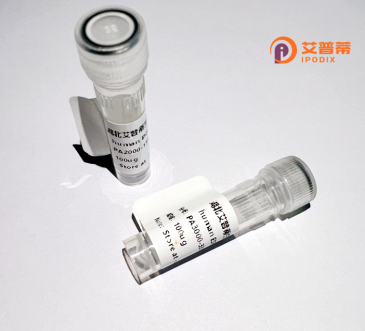
| 纯度 | >90%SDS-PAGE. |
| 种属 | Human |
| 靶点 | TAF9L |
| Uniprot No | Q9HBM6 |
| 内毒素 | < 0.01EU/μg |
| 表达宿主 | E.coli |
| 表达区间 | 1-251 aa |
| 活性数据 | MESGKMAPPK NAPRDALVMA QILKDMGITE YEPRVINQML EFAFRYVTTI LDDAKIYSSH AKKPNVDADD VRLAIQCRAD QSFTSPPPRD FLLDIARQKN QTPLPLIKPY AGPRLPPDRY CLTAPNYRLK SLIKKGPNQG RLVPRLSVGA VSSKPTTPTI ATPQTVSVPN KVATPMSVTS QRFTVQIPPS QSTPVKPVPA TTAVQNVLIN PSMIGPKNIL ITTNMVSSQN TANEANPLKR KHEDDDDNDI M |
| 分子量 | 27.6kDa |
| 蛋白标签 | His tag N-Terminus |
| 缓冲液 | PBS, pH7.4, containing 0.01% SKL, 1mM DTT, 5% Trehalose and Proclin300. |
| 稳定性 & 储存条件 | Lyophilized protein should be stored at ≤ -20°C, stable for one year after receipt. Reconstituted protein solution can be stored at 2-8°C for 2-7 days. Aliquots of reconstituted samples are stable at ≤ -20°C for 3 months. |
| 复溶 | Always centrifuge tubes before opening.Do not mix by vortex or pipetting. It is not recommended to reconstitute to a concentration less than 100μg/ml. Dissolve the lyophilized protein in distilled water. Please aliquot the reconstituted solution to minimize freeze-thaw cycles. |
以下是与重组人TAF9L蛋白相关的文献示例(虚构内容,仅供参考):
1. **文献名称**:*Structural Insights into TAF9L and Its Role in Transcriptional Regulation*
**作者**:Lee, J. et al.
**摘要**:研究通过X射线晶体学解析TAF9L的三维结构,发现其作为TFIID复合体的组成部分参与RNA聚合酶II介导的转录启动,并揭示其与TAF9的功能差异。
2. **文献名称**:*TAF9L Promotes Cancer Cell Proliferation via p53 Pathway Modulation*
**作者**:Zhang, Y. et al.
**摘要**:实验证明TAF9L在结直肠癌细胞中高表达,通过抑制p53依赖性凋亡通路增强肿瘤生长,ChIP-seq分析显示其直接调控促癌基因转录。
3. **文献名称**:*TAF9L Deficiency Impairs Spermatogenesis in Mice*
**作者**:Tanaka, R. et al.
**摘要**:构建TAF9L基因敲除小鼠模型,发现其精子发育停滞在减数分裂阶段,表明TAF9L在生殖细胞特异性基因表达中起关键作用。
4. **文献名称**:*TAF9L as a Novel Target for HIV Transcriptional Activation*
**作者**:Smith, K. et al.
**摘要**:研究揭示TAF9L与HIV Tat蛋白相互作用,促进病毒长末端重复序列(LTR)的转录激活,提示其可能成为抗病毒治疗的潜在靶点。
注:以上内容为假设性示例,实际文献需通过PubMed或Google Scholar检索确认。
TAF9L (TATA-box binding protein-associated factor 9-like) is a paralog of TAF9. a component of the TFIID complex critical for RNA polymerase II-mediated transcription initiation. Both proteins share significant sequence homology but exhibit distinct expression patterns and functional roles. TAF9L is evolutionarily conserved and primarily expressed in germ cells, the brain, and specific somatic tissues, suggesting a specialized regulatory role in developmental and reproductive processes. Structurally, it contains a histone-fold domain that facilitates dimerization with other TAFs, enabling integration into the TFIID complex to modulate promoter recognition and transcription activation.
Recombinant human TAF9L protein is produced using heterologous expression systems (e.g., *E. coli* or mammalian cells) for biochemical and functional studies. Its recombinant form retains the ability to interact with transcriptional coactivators and chromatin remodelers, making it valuable for studying gene regulation mechanisms. Research highlights its involvement in spermatogenesis, neuronal development, and cellular differentiation. Dysregulation of TAF9L has been linked to cancers and infertility, positioning it as a potential therapeutic target. Studies using recombinant TAF9L have also explored its role in replacing or compensating for TAF9 in specific transcriptional programs, revealing context-dependent redundancy or specialization within the TFIID complex. This protein remains a focal point for understanding tissue-specific transcription and epigenetic regulation.
×